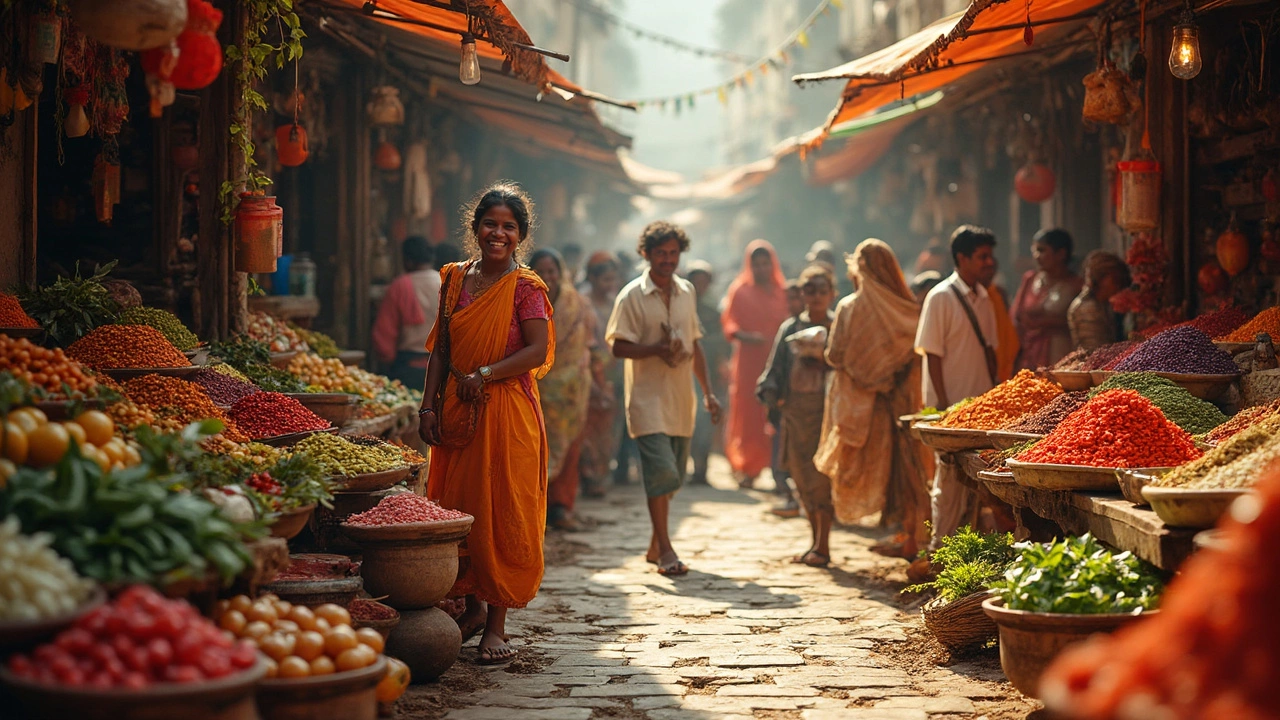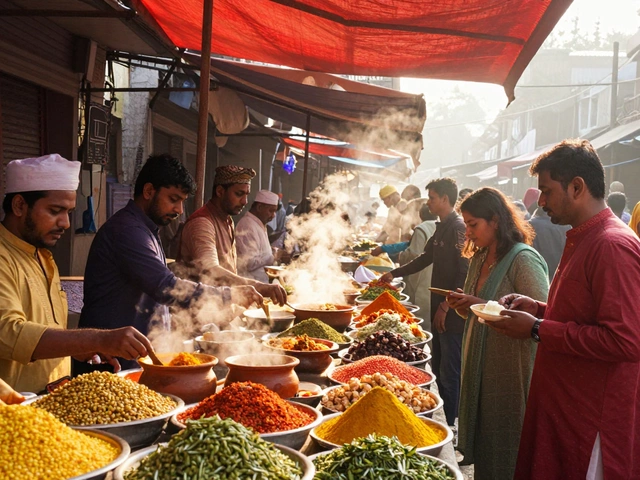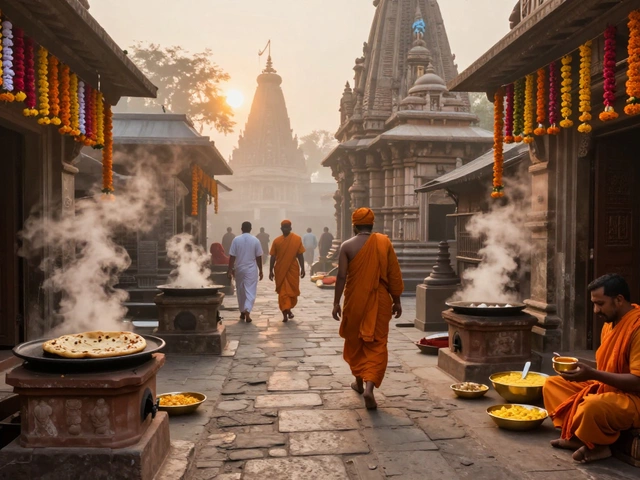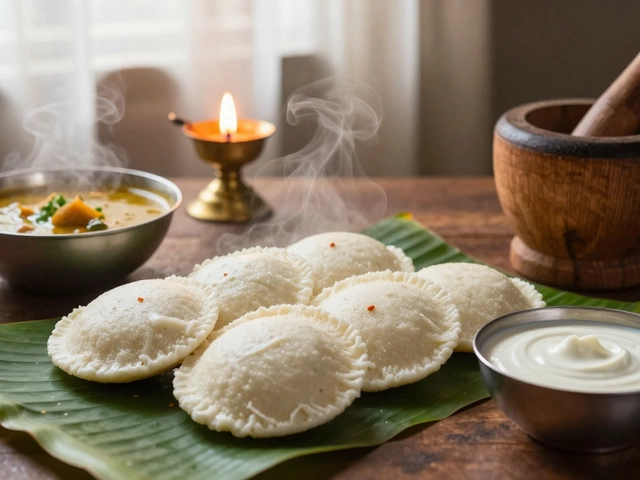Indian food is a feast for the senses. The rich spices, vibrant colors, and bold flavors are enough to make anyone's mouth water. But did you know it can also be super healthy? Yep, we're talking about meals that are not just delicious, but packed with good-for-you nutrients too. If you've ever felt confused about what Indian dishes might be healthiest, you're definitely not alone.
Picture this: an Indian curry bubbling away on the stove, full of veggies, lentils, and just the right amount of spices. This isn’t just a treat for your taste buds; it’s also a powerhouse of vitamins, minerals, and antioxidants. Many Indian dishes rely on pantry staples like turmeric, cumin, and ginger, which all bring their own set of health benefits to the table.
Want to make healthier choices without sacrificing taste? Start by including more plant-based options, like dal or chickpea curry. These dishes are usually lower in fat and higher in fiber, making them a great choice for anyone looking to eat a bit cleaner. Plus, with their bold flavors, you won't even miss the heavier, creamier fare.
- Why Indian Food Can Be Extremely Healthy
- Top Healthiest Indian Ingredients
- Must-Try Healthy Indian Dishes
- Cooking Tips for Healthier Indian Meals
- Balancing Flavors and Nutrition
Why Indian Food Can Be Extremely Healthy
When you think about Indian food, you might picture rich curries or buttery naans. But here's the scoop—healthiest Indian food isn't just a myth; it's real, and way more common than you'd think. Indian cuisine is like a treasure trove of health benefits if you know what to pick. Let's demystify this culinary magic.
First off, spices are more than just zesty flavors. Take turmeric, for example. Packed with curcumin, turmeric is known for its anti-inflammatory properties and can bolster your immune system. Ginger and garlic, staple ingredients in many Indian dishes, aren't just there to make things taste good. They're also loaded with components that can improve heart health and fight off colds.
Let's talk ingredients. Many traditional Indian recipes are heavily plant-based, incorporating ingredients like lentils, beans, and veggies. Not only do these ingredients add flavors, but they're also loaded with fiber, which can improve your digestion and keep you feeling full longer. Lentils, found in dishes like dal, are especially great because they're a rich source of plant protein and low in fat.
Oil use is another thing to keep an eye on. Opt for healthier options like mustard or coconut oil, which are commonly used in Indian cooking. These oils add essential fatty acids that can improve brain function and skin health.
| Common Ingredient | Health Benefit |
|---|---|
| Turmeric | Anti-inflammatory, boosts immunity |
| Ginger | Improves digestion, fights nausea |
| Lentils | High in protein, rich in fiber |
| Coconut Oil | Heart-healthy fats, improves skin health |
In a nutshell, if you combine the right spices with whole ingredients and controlled cooking techniques, you can whip up healthy Indian meals without missing out on flavors. So, next time you're cooking or ordering in, think about what goes into your bowl. Your taste buds—and your body—will thank you.
Top Healthiest Indian Ingredients
When it comes to making some of the healthiest Indian food, the magic really lies in the ingredients. Let's take a closer look at some staples that can seriously boost the nutritional value of your meals.
First up, turmeric. This golden spice isn't just pretty; it's known for its anti-inflammatory properties thanks to curcumin, its active compound. Including turmeric in your dishes can add both flavor and health benefits. A sprinkle here and there can do wonders for your body.
Next, let's chat about lentils. They're a staple in dishes like dal, packing a punch with protein, fiber, and iron. Lentils are perfect if you're looking to manage your weight or keep your heart healthy, plus they're easy to cook and fill you up nicely.
Ginger is another rockstar. It’s not only awesome for adding a zing to your food but also works magic for your digestion and can even help fight off colds. A little fresh ginger in your curry or tea can go a long way in keeping you feeling great.
Then there's garlic. Sure, it might not do your breath any favors, but its potential health perks are worth it! Garlic is acclaimed for its heart health benefits and ability to lower cholesterol levels. Plus, it tastes delish when sautéed with onions for a savory base.
Chickpeas deserve a mention too. Loaded with protein and fiber, they're great for keeping you full and satisfied. Whether in a chana masala or a simple salad, chickpeas are a fantastic ingredient in healthy Indian meals.
| Ingredient | Main Benefits |
|---|---|
| Turmeric | Anti-inflammatory |
| Lentils | High in Protein and Fiber |
| Ginger | Improves Digestion |
| Garlic | Heart Health |
| Chickpeas | Protein and Fiber Source |
Next time you're at the grocery store, throw some of these ingredients into your cart. Mix them into your meals, and you're not just cooking; you’re creating something deliciously nutritious!

Must-Try Healthy Indian Dishes
Alright, let’s jump into some Indian dishes that are both delicious and good for your body. First up is dal – this comforting lentil stew is full of protein and fiber. With its base of spices like turmeric and cumin, it not only warms your soul but also gives a health boost. Dal is super versatile and can be whipped up in no time. Paired with brown rice or millet, it makes for a balanced meal.
Got a soft spot for curries? Then you’ve got to try chana masala, a robust chickpea dish that's easy to make and super nutritious. It's rich in vitamins, minerals, and fiber, and it doesn’t skimp on flavor. The chickpeas offer plant-based protein, so you feel full and satisfied without any meat.
Another winner in the healthiest Indian food realm is paneer tikka, especially when grilled. This is a must-try if you're looking for something cheesy yet healthy. Paneer, or Indian cottage cheese, is marinated in spices and grilled to perfection. It’s low in carbs, high in protein, and when paired with bell peppers, onions, and tomatoes, it ticks all the health boxes.
If you're after something green, go for palak paneer. Imagine creamy spinach blended with aromatic spices and paneer cubes. What’s awesome about spinach is that it’s loaded with iron and vitamins, making this dish a perfect pick if you're watching your nutrient intake.
While we're at it, let's not forget the mighty idli – those light, fluffy rice cakes that are a staple in South Indian breakfasts. When steamed, they hold onto their nutrients and are a great source of carbs and protein. Pair them with fresh coconut chutney or sambar, and you have a meal that’s as healthy as it is tasty.
Here’s a little snapshot of these healthy Indian meals and their key ingredients, making it easy to remember:
| Dish | Main Ingredient | Health Benefit |
|---|---|---|
| Dal | Lentils | High in Protein and Fiber |
| Chana Masala | Chickpeas | Rich in Vitamins and Fiber |
| Paneer Tikka | Paneer | Low in Carbs, High in Protein |
| Palak Paneer | Spinach, Paneer | Iron and Vitamin-rich |
| Idli | Rice, Urad Dal | Good Carbs and Protein |
So, next time you’re craving Indian food, try these dishes for a meal that’s as nourishing as it is tasty. Trust me, your tastebuds (and your body) will thank you!
Cooking Tips for Healthier Indian Meals
Cooking up some healthy Indian meals at home is easier than you might think, and a few simple tweaks can make all the difference. First things first, bring on the veggies! The more colorful your plate, the better it usually is for you. Try adding vegetables like spinach, bell peppers, and cauliflower to your dishes. They not only add nutrients but also make the dish look vibrant and tasty.
Now let’s talk about cooking methods. Instead of deep-frying samosas or pakoras, try baking them. It’s a game-changer that cuts down on excess oil while keeping the crunch factor intact. Also, consider steaming or grilling instead of frying when possible. These methods retain the food's natural flavors and nutritional value.
Next up, spice it right! Spices are the heart of Indian cuisine and using fresh spices can enhance both flavor and health. Turmeric is known for its anti-inflammatory properties, while cumin can aid digestion. Instead of heavy sauces, focus on using these seasonings to add depth to your dishes.
Here's a little secret: Swap out your usual rice for brown rice or quinoa. They are higher in fiber and protein, turning your meal into a balanced feast. If dairy is a part of your meal, opt for yogurt instead of cream. It’s a lighter option that still adds that creamy texture we all love.
When it comes to cooking oil, moderation is key. Go for heart-healthy oils like olive or mustard oil in reasonable amounts. And don't forget, homemade meals allow you to control the amount of salt and sugar. Opt for a sprinkle of lemon juice for that extra zing instead of extra salt.
Finally, don’t forget to taste and adjust as you cook. The beauty of making your own easy Indian dishes is that you can tweak them to your preference, making them both delicious and nourishing. So go ahead, experiment in your kitchen and enjoy the healthy ride!

Balancing Flavors and Nutrition
Getting the right balance between flavor and nutrition in Indian recipes is like finding the perfect yoga pose—comfortably challenging! The key is to use spices smartly while keeping an eye on the nutritional content. Adding too much cream or butter might give you that rich taste, but it can also amp up the calories faster than you think. Luckily, there are some nifty tricks to keep things flavorful without going overboard.
For starters, spices are your best friend. Think turmeric, a spice known for its anti-inflammatory properties, or cumin, which aids digestion. These not only boost the taste but also add healthy perks to your dish. Another tip is to swap out high fat ingredients for lighter options. For instance, instead of cream, try using yogurt or coconut milk—it’s lighter and still adds that creamy goodness.
- Boost Protein: Lentils and chickpeas are fantastic sources of plant-based protein in healthy Indian meals. They’re also high in fiber, keeping you full longer and stabilizing blood sugar levels.
- Select Whole Grains: Make the switch from regular white rice to brown rice or quinoa. These grains not only add more nutrients but also provide a nice, nutty flavor.
- Portion Control: It’s easy to lose track of portions, especially when a dish is delicious. Be mindful and serve reasonable portions, pairing your meal with fresh salads or grilled veggies.
If you're a data enthusiast, think about this:
| Ingredient | Calories (per 100g) | Protein (per 100g) |
|---|---|---|
| Chickpeas | 164 | 8.9g |
| Lentils | 116 | 9.0g |
| Brown Rice | 111 | 2.6g |
So, when diving into easy Indian recipes, remember that a little tweak can help you savor your meal guilt-free. The next time you whip up a curry or stir up a spicy dal, think about how you can keep your meal flavorful yet healthy. Trust me, your body will thank you!





